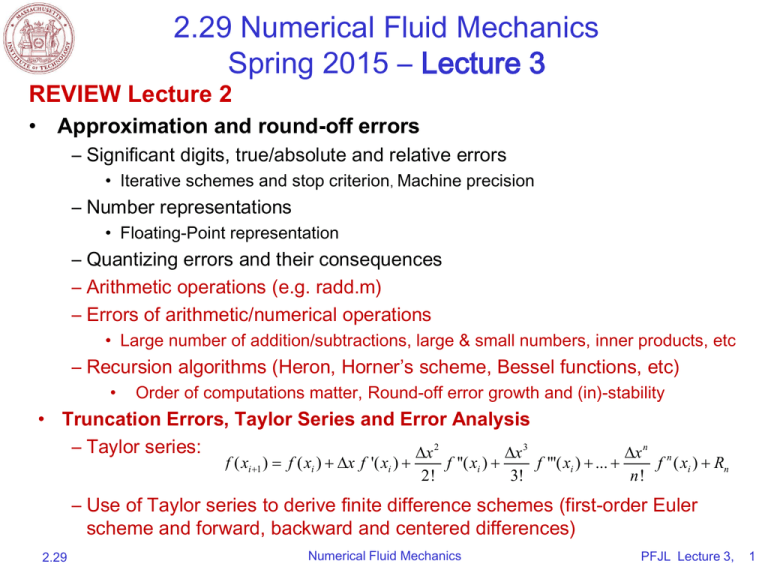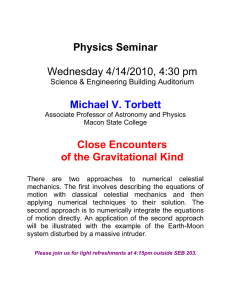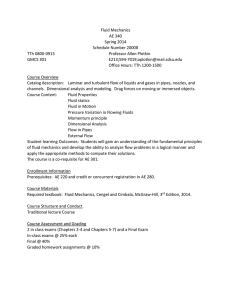2.29 Numerical Fluid Mechanics Spring 2015 – Lecture 3 REVIEW Lecture 2 •
advertisement

2.29 Numerical Fluid Mechanics
Spring 2015 – Lecture 3
REVIEW Lecture 2
• Approximation and round-off errors
– Significant digits, true/absolute and relative errors
• Iterative schemes and stop criterion, Machine precision
– Number representations
• Floating-Point representation
– Quantizing errors and their consequences
– Arithmetic operations (e.g. radd.m)
– Errors of arithmetic/numerical operations
• Large number of addition/subtractions, large & small numbers, inner products, etc
– Recursion algorithms (Heron, Horner’s scheme, Bessel functions, etc)
•
Order of computations matter, Round-off error growth and (in)-stability
• Truncation Errors, Taylor Series and Error Analysis
– Taylor series:
x 2
x 3
x n n
f ( xi 1 ) f ( xi ) x f '( xi )
f ''( xi )
f '''( xi ) ...
f ( xi ) Rn
2!
3!
n!
– Use of Taylor series to derive finite difference schemes (first-order Euler
scheme and forward, backward and centered differences)
2.29
Numerical Fluid Mechanics
PFJL Lecture 3,
1
2.29 Numerical Fluid Mechanics
Spring 2015 – Lecture 3
REVIEW Lecture 2, Cont’d
• Truncation Errors, Taylor Series and Error Analysis
– General error propagation formulas and error estimation, with examples
Consider y f ( x1 , x2 , x3 ,..., xn ).
If i 's are magnitudes of errors on xi's, what is the error on y ?
n
• The Differential Formula: y
i 1
f ( x1 ,..., xn )
i
xi
• The Standard Error (statistical formula):
E ( s y )
2
ff 2
i
xxi
i 1
n
– Error cancellation (e.g. subtraction of errors of the same sign)
x f '( x )
– Condition number: K p
f (x)
• Well-conditioned problems vs. well-conditioned algorithms
• Numerical stability
Reference: Chapra and Canale,
Chapters 3 and 4
2.29
Numerical Fluid Mechanics
PFJL Lecture 3,
2
Numerical Fluid Mechanics:
Lectures 3 and 4 Outline
• Roots of nonlinear equations
– Bracketing Methods
Reference: Chapra and Canale,
Chapter 5
• Example: Heron’s formula
• Bisection
• False Position
– “Open” Methods
• Open-point Iteration (General method or Picard Iteration)
– Examples
– Convergence Criteria
– Order of Convergence
• Newton-Raphson
– Convergence speed and examples
• Secant Method
– Examples
– Convergence and efficiency
• Extension of Newton-Raphson to systems of nonlinear equations
– Roots of Polynomial (all real/complex roots)
• Open methods (applications of the above for complex numbers)
• Special Methods (e.g. Muller’s and Bairstow’s methods)
2.29
Numerical Fluid Mechanics
PFJL Lecture 3,
3
Error Propagation Example with Differential Approach:
Multiplications
Error Propagation Formula
Multiplication
=>
=>
=>
=>
εr y
εr i
Relative Errors Add for Multiplication
Another example, more general case:
εr y
2.29
Numerical Fluid Mechanics
εr i
PFJL Lecture 3,
4
Statistical Error Propagation Estimate:
Error Expectations and the “Standard Error”
Example: Addition
a. Chopping
Error Expectation:
on average, half the interval is chopped, hence
b. Rounding
2.29
Numerical Fluid Mechanics
PFJL Lecture 3,
5
Statistical Error Propagation Estimate:
Error Expectations and the “Standard Error”
y y( x1, x2 , x3 ,..., xn )
Standard Error
(assuming indep. Gaussian errors on xi ,
compute error standard deviation on y)
2
Example: Addition
n
Standard Error is a more accurate measure of expected errors:
It is likely that the error will be of that magnitude.
However, the general error propagation formula is an upper bound
(if higher order terms can be neglected)
2.29
Numerical Fluid Mechanics
PFJL Lecture 3,
6
Note on Error Propagation: Error Cancellation
(occurs when errors of the same sign are subtracted)
Example: Consider this function of one variable, to be evaluated at x = 100
Define:
For 2 terms (z1 and z2):
Gen. error (max):
Direct error
(single y term):
2
Error cancellation
Stand. Error :
2
error if 4 digits
2.29
Numerical Fluid Mechanics
PFJL Lecture 3,
7
The Condition Number
• The condition of a mathematical problem relates to its
sensitivity to changes in its input values
• A computation is numerically unstable if the
uncertainty of the input values are magnified by the
numerical method
• Considering x and f(x), the condition number is the
ratio of the relative error in f(x) to that in x.
• Using first-order Taylor series f ( x) f ( x ) f '( x )( x x )
• Relative error in f(x):
• Relative error in x:
f ( x ) f ( x ) f '( x )( x x )
f (x)
f (x)
(x x)
x
• Condition Nb = Ratio of relative errors: K p
2.29
Numerical Fluid Mechanics
x f '( x )
f (x)
PFJL Lecture 3,
8
Error Propagation
Condition Number: another derivation and an example
y = f(x)
x
x
y
y
y y (1 )
x x (1 )
f ( x ) f ( x ) (1 )
Problem Condition Number
Problem ill-conditioned
Error cancellation example:
-0.5 10-4
With first-order
Taylor series
2.29
0.2 10-4
⇒ Well-conditioned problem
Numerical Fluid Mechanics
PFJL Lecture 3,
9
Error Propagation
Problem vs. Algorithm Condition Numbers
a. Problem Condition Number
K A is the algorithm condition number,
which may be much larger than KP due
to digitized number representation.
0.5 10-4
2
0.5
10-4
0.5
10-2
Solution:
•
•
1.0
Higher precision
Rewrite algorithm
b. Algorithm Condition Nb. (4 significant digits, rounding)
Well-conditioned Algorithm
(base 10)
Algorithm Condition Number
2.29
Numerical Fluid Mechanics
PFJL Lecture 3,
10
Roots of Nonlinear Equations
• Finding roots of equations (x | f (x) = 0) ubiquitous in engineering
problems, including numerical fluid dynamics applications
– In general: finding roots of functions (implicit in unknown parameters/roots)
– Fluid Application Examples
•
•
•
•
Implicit integration schemes
Stationary points in fluid equations, stability characterizations, etc
Fluid dynamical system properties
Fluid engineering system design
• Most realistic root finding problems require numerical methods
• Two types of root problems/methods:
1.Determine the real roots of algebraic/transcendental equations (these
methods usually need some sort of prior knowledge on a root location)
2.Determine all real and complex roots of polynomials (all roots at once)
2.29
Numerical Fluid Mechanics
PFJL Lecture 3,
11
Roots of Nonlinear Equations
• Bracketing Methods
– Bracket root, systematically reduce width of bracket, track error for
convergence
– Methods: Bisection and False-Position (Regula Falsi)
• “Open” Methods
– Systematic “Trial and Error” schemes, don’t require a bracket (can start
from a single value)
– Computationally efficient, but don’t always converge
– Methods: Open-point Iteration (General method or Picard Iteration),
Newton-Raphson, Secant Method
– Extension of Newton-Raphson to systems of nonlinear equations
• Roots of Polynomials (all real/complex roots)
– Open methods (applications of the above for complex numbers)
– Special Methods (e.g. Muller’s and Bairstow’s methods)
2.29
Numerical Fluid Mechanics
PFJL Lecture 3,
12
Roots of Nonlinear Equations: Bracketing Methods
Example – Square root
Heron’s Principle
Guess root
If
If
heron.m
i
Mean is better guess
(
)/2
Iteration Formula
(
2.29
a=2;
n=6;
g=2;
% Number of Digits
dig=5;
sq(1)=g;
for i=2:n
sq(i)= 0.5*radd(sq(i-1),a/sq(i-1),dig);
end
'
i
value
'
[ [1:n]' sq']
hold off
plot([0 n],[sqrt(a) sqrt(a)],'b')
hold on
plot(sq,'r')
plot(a./sq,'r-.')
plot((sq-sqrt(a))/sqrt(a),'g')
legend('sqrt','xn','s/xn','Relative Err')
grid on
1.0000
2.0000
3.0000
4.0000
5.0000
6.0000
value
2.0000
1.5000
1.4167
1.4143
1.4143
1.4143
)/2
Numerical Fluid Mechanics
PFJL Lecture 3,
13
Bracketing Methods: Graphical Approach
A function typically changes sign at the vicinity of the root “bracket” the root
f(x)
f(x)
f(x)
x
xt
(i)
xa
xt
(ii)
f(x)
x
x
x
xa
xt
f(x)
xa
(i)
xt
xa
(ii)
f(x)
x
x
xt
xa
(iii)
xt
xa
(iv)
Image by MIT OpenCourseWare.
These graphs show general ways in which roots may occur
on a bounded interval. In (i) and (ii), if the function is
positive at both boundaries, there will be either an even
number of roots or no roots; in the other two graphs, if the
function has opposite signs at the boundary points, there
will be an odd number of roots within the interval.
2.29
These graphs show some exceptions to the general cases
illustrated on the left. In (i), a multiple root occurs where
the function is tangential to the x axis. There are an even
number of intersections for the interval. In (ii) is depicted
a discontinuous function with an even number of roots
and end points of opposite signs. Finding the roots in
such cases requires special strategies.
Numerical Fluid Mechanics
PFJL Lecture 3,
14
Roots of Nonlinear Equations: Bracketing Methods
Bisection
Incremental search method defined as:
“Keep dividing in two the interval within which at least one root lies”
Algorithm
f(x)
n = n+1
x
yes
no
2.29
Numerical Fluid Mechanics
PFJL Lecture 3,
15
Roots of Nonlinear Equations: Bracketing Methods
Bisection
% Root finding by bi-section
f=inline(' a*x -1','x','a');
a=2
figure(1); clf; hold on
x=[0 1.5]; eps=1e-3;
err=max(abs(x(1)-x(2)),abs(f(x(1),a)-f(x(2),a)));
while (err>eps & f(x(1),a)*f(x(2),a) <= 0)
xo=x; x=[xo(1) 0.5*(xo(1)+xo(2))];
if ( f(x(1),a)*f(x(2),a) > 0 )
x=[0.5*(xo(1)+xo(2)) xo(2)]
end
x
err=max(abs(x(1)-x(2)),abs(f(x(1),a)-f(x(2),a)));
b=plot(x,f(x,a),'.b'); set(b,'MarkerSize',20);
grid on;
end
bisect.m
Algorithm
n = n+1
Stop criterion above based on x~0 and f(x)~0
a*x-1=0, with a=2
yes
no
2.29
Numerical Fluid Mechanics
PFJL Lecture 3,
16
Roots of Nonlinear Equations: Bracketing Methods
Bisection
• Stop criteria:
– absolute added values go to zero: x~0 and f(x)~0
– better to stop when relative estimated error, i.e. relative added
value, is negligible:
a
xˆ nr xˆrn 1
s
n
xˆ r
• Each successive iteration halves the maximum error, a
general formula thus relates the error and the number of
iterations:
x 0
n log 2
Ea , d
where x0 is an initial error and Ea ,d the desired error
2.29
Numerical Fluid Mechanics
PFJL Lecture 3,
17
Another Bracketing Method:
The False Position Method (Regula Falsi)
• Bisection is a brute force scheme
– Somewhat inefficient approach
– Doesn’t account for magnitudes of f(xL) and f(xU)
• False Position
f ( xr ) f ( xU )
f ( xU ) f ( xL )
( xr xU ) 0
xU xL
f ( xU ) ( xL xU )
xr xU
f ( xL ) f ( xU )
f(x)
f(xu)
f ( xL )
f ( xU )
( xr xL ) ( xr xU )
xr
xL
xr xU
2.29
f ( xU ) ( xL xU )
f ( xL ) f ( xU )
xu
x
f(xL)
Image by MIT OpenCourseWare.
A graphical depiction of the false position method, Regula Falsi.
Shaded in green are the triangles use to derive the method.
Numerical Fluid Mechanics
PFJL Lecture 3,
18
Comments on Bracketing Methods
(Bisection and False Postion)
• Bisection and False Position:
– Convergent methods, but can be slow and thus can require lots of
function evaluations, each of which can be very expensive (full code).
• Error of False Position can decrease much faster than that of
Bisection, but if the function is far from a straight line, False
Position will be slow (one of the end point remains fixed)
• Remedy: “Modified False Position”
– e.g. if end point remains fixed for a few iterations, reduce end-point
function value at end point, e.g. divide interval by 2
• One can not really generalize behaviors for Root Finding
methods (results are function dependent)
• Always substitute estimate of root xr at the end to check how
close estimate is to f(xr)=0
2.29
Numerical Fluid Mechanics
PFJL Lecture 3,
19
Roots of Nonlinear Eqs.: Open Methods
Fixed Point Iteration (General Method or Picard Iteration)
Example: Cube root
% f(x) = x^3 - a = 0
% g(x) = x + C*(x^3 - a)
a=2;
n=10;
g=1.0;
C=-0.1;
sq(1)=g;
for i=2:n
sq(i)= sq(i-1) + C*(sq(i-1)^3 -a);
end
hold off
plot([0 n],[a^(1./3.) a^(1./3.)],'b')
hold on
plot(sq,'r')
plot( (sq-a^(1./3.))/(a^(1./3.)),'g')
grid on
cube.m
Non-linear Equation
Goal: Converging series
Rewrite Problem
Example
Iteration
2.29
Numerical Fluid Mechanics
PFJL Lecture 3,
20
Roots of Nonlinear Equations:
Bracketing vs. Open Methods in Graphics
f(x)
f(x)
xi
xi+1
x
f(x)
xl
xu
xl
xu
xl
xi
xi+1
x
x
xu
xl
xu
xl xu
Image by MIT OpenCourseWare.
A graphical depiction of the fundamental differences between the bracketing
method (shown on the right) and the open methods (shown on the left).
On the right, the root is constrained within the interval; on the left,
a formula is used to project iteratively between xi and xi+1 and can
diverge or converge rapidly.
2.29
Numerical Fluid Mechanics
PFJL Lecture 3,
21
Open Methods (Fixed Point Iteration)
Stop-criteria
“Unrealistic” stop-criteria: continue while
Realistic stop-criteria
Machine
Epsilon
Use an “or” combination of the two criteria
f(x)
f(x)
‘flat’ f(x)
‘steep’ f(x)
d
x
x
Cannot require
Cannot require
d
2.29
Numerical Fluid Mechanics
PFJL Lecture 3,
22
MIT OpenCourseWare
http://ocw.mit.edu
2.29 Numerical Fluid Mechanics
Spring 2015
For information about citing these materials or our Terms of Use, visit: http://ocw.mit.edu/terms.



